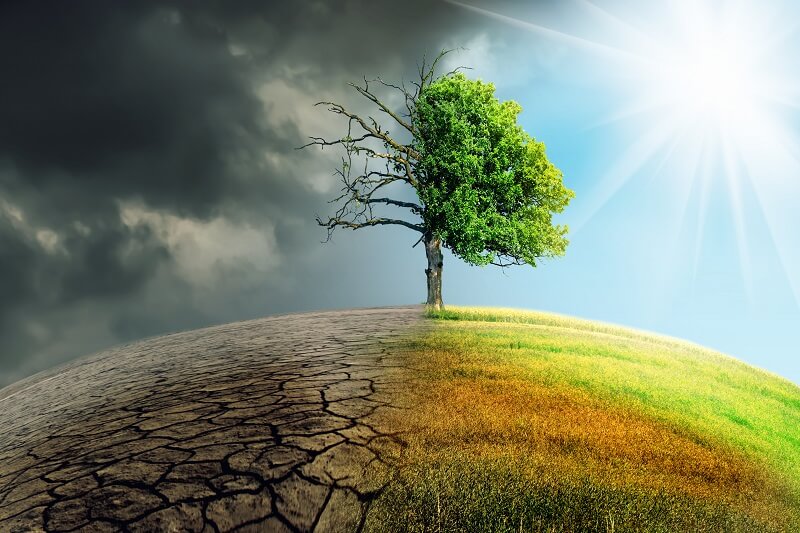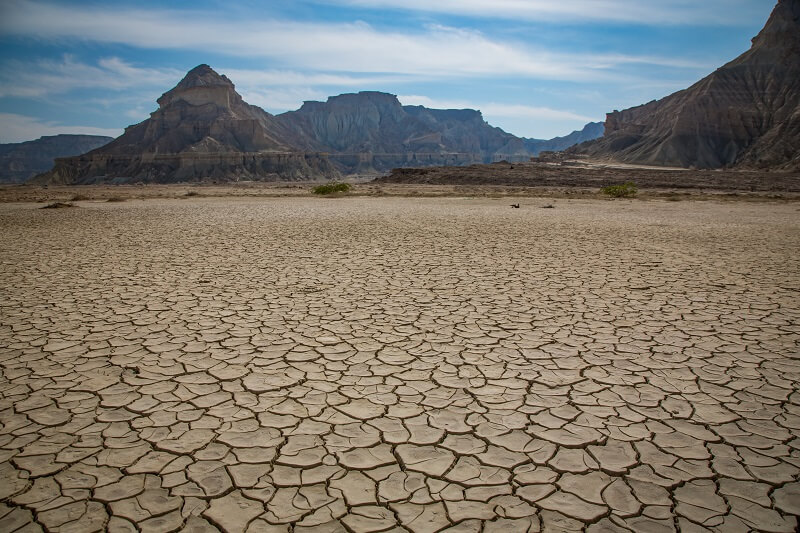Definition
Abiotic factors, also called abiotic components are non-living factors that impact an ecosystem. Abiotic factors are part of the ecosystem and can impact the associated living things, but they are not living. The term “abiotic” comes from the root parts “a-” meaning “without,” and “bio,” meaning “life.” The living parts of an ecosystem are called “biotic factors.”

Examples of Abiotic Factors
Common examples of abiotic factors include:
- Wind
- Rain
- Humidity
- Latitude
- Temperature
- Elevation
- Soil composition
- Salinity (the concentration of salt in water)
- Radiation
- Pollution
Abiotic factors make up much of the variation seen between different ecosystems. By determining the availability of essential resources such as sunlight, water, oxygen, and minerals, abiotic factors influence which organisms can survive in a given place.
The following are a few examples of how abiotic factors can shape ecosystems by determining which organisms can live in them, and what those organisms must do to survive.
In many places, prairie or savannah ecosystems evolve instead of forest or jungle ecosystems, for example, because there is not enough rain to support trees. Other factors, such as high winds and soil that is poor in essential nutrients, may also help to create an environment in which trees cannot survive but prairie plants are prevalent.
Abiotic factors may also include added challenges to life forms, such as temperature extremes, high winds, or even pollution. Human activity has also become an important factor in determining which life forms survive in some ecosystems.
Desert Abiotic Factors

Perhaps the most obvious biome that is determined by abiotic factors is the desert. Because of low rainfall, deserts develop ecosystems that are highly distinct from those of any other habitat.
Scientists use the term “desert” to refer to any area which has less than 25 cm, or 9.75 inches, of rain or snow in an average year. By this definition, deserts cover about 20% of Earth’s land area, including the continent of Antarctica.
Desert ecosystems can also experience extreme temperature swings because open water and water vapor act as temperature stabilizing elements in wetter biomes.
Between the low rainfall and the often extreme temperatures, deserts develop unique organisms and food chains.
Tropical Rainforest Abiotic Factors
At the other end of the spectrum, tropical rainforests are one of the wettest ecosystems on Earth. To be classified as a rainforest, an area must receive at least 75 inches (190 cm) of rain per year. Most rainforests get well over 100 inches (254 cm) annually.
Tropical rainforests are rainforests located in the tropics. The tropics form a belt around the equator and receive a great deal of sunlight throughout the year, resulting in warm temperatures and mild seasons.
Due to their warm and wet climates, rainforests develop extremely dense, lush, and complex ecosystems. Rainforests are unique in that they consist of life layered on top of life. Most scientists divide tropical rainforests into six different layers, each of which hosts different types of life!
The topmost layer of the rainforest – the “canopy” – receives the most sunlight, while the bottom-most layers receive very little sunlight because of shade from plants in the other layers. This impacts the species that are able to grow in these layers.
Tundra Abiotic Factors

Another unique type of biome created by abiotic factors is the tundra.
Tundras are located in the north polar region, where they receive very little light and heat from the sun. As a result, only a thin, top layer of soil thaws sufficiently to allow plant growth. A deep layer of soil, called subsoil, can remain frozen for thousands of years.
Because the subsoil remains frozen, trees (which require deep roots) cannot grow in the tundra. Instead, grasses and other small plants that can grow in the thin soil flourish.
Abiotic Factors in the Ocean
The ocean hosts some unique abiotic factors. Notably, the ocean contains salt. It also has the attribute of depth, which affects the amount of sunlight that sea life receives.
The saltiness of the ocean is important for the animals living there. All creatures must adapt to prevent the ocean’s salt from disrupting their biochemistry. Dolphins that swim in the ocean get all of their water from their prey animals because the saltwater would dehydrate them. Some fish can survive only in saltwater because they have adapted so well to the environment.
The ocean, like the rainforest, also has a number of different zones that receive different amounts of sunlight and host very different types of life. This is because water itself both blocks out and absorbs sunlight.
Life in the topmost zone of the ocean, called the epipelagic zone, receives a large amount of sunlight. This is where photosynthetic ocean life, like coral and seaweed, is found.
By contrast, the abyssopelagic zone at the bottom of the ocean receives almost no sunlight. This part of the ocean hosts strange sea creatures, some of which cannot survive at the surface because their body structures depend on the high water pressure at depth.
The very deep trenches of the ocean contain an even colder, darker zone called the “hadopelagic.” This zone is named after the Greek underworld.
As a result of these abiotic factors, there are different ocean ecosystems, such as shoreline ecosystems, coral reef ecosystems, and deep ocean ecosystems.
Abiotic Factors in Other Ecosystems
The biomes described above are not the only ecosystems impacted by abiotic factors. Ecosystems make up the entirety of the earth’s surface, and abiotic factors impact all the living things within them. For example, abiotic factors also shape the features of the following ecosystems:
- Temperate rainforests, sometimes called temperate broad-leaved forests, are characterized by mild, seasonal climates. They are less dense than tropical rainforest due to the milder weather but still play host to rich biomes.
- Freshwater ecosystems represent the non-marine aquatic ecosystems, including rivers, ponds, lakes, springs, and wetlands. Abiotic factors affecting these ecosystems include temperature, light penetration, and pH of the water.
- Grasslands are ecosystems primarily dominated by grass, lacking the abundance of trees required to be considered a forest. These ecosystems are defined by the rainfall: there is too much to be considered a desert, but not enough to support a forest ecosystem.
- Taiga ecosystems are cold forest regions found in the subarctic. They are characterized by the presence of evergreen trees, and other plants that can survive the cold such as mosses and mushrooms. The animals include moose, bear, deer, and lynx.
Human Activity: Pollution and the Peppered Moth

In the United Kingdom, two types of moths were present at the beginning of the 19th century. By far the most common was the white-bodied peppered moth, whose black-speckled white body allowed it to blend in with tree bark to avoid being eaten by birds.
During the Industrial Revolution, however, coal-burning factories in cities in the United Kingdom produced massive amounts of ash, which covered the surrounding forests. As a consequence, white-bodied moths now stood out against the dark tree trunks, but black-bodied moths, who had once been at a disadvantage against the pale tree bark, could now hide more effectively.
In subsequent decades, naturalists studying the peppered moth found that black-bodied moths were dominant near cities with factories, whereas white-bodied moths remained dominant in the soot-free forests of rural areas. To learn more about this fascinating story, visit this article.
Abiotic Factors vs Biotic Factors
Whereas abiotic factors are the non-living factors that influence an ecosystem, biotic factors are all the living components. Biotic factors include the organisms and any decaying organic matter present in the environment. There are various differences between biotic and abiotic factors, but both have profound effects on the balance of an ecosystem. To learn more, visit this article, which compares the features of abiotic and biotic factors.
Quiz
